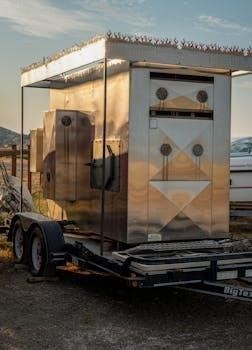list of flat towable vehicles pdf

Flat towing, also known as dinghy towing or four-down towing, involves pulling a vehicle behind a motorhome with all four wheels on the ground․ This method requires vehicles specifically designed or approved for this․
Understanding Flat Towing
Flat towing, a popular method for recreational vehicle enthusiasts, involves pulling a vehicle behind a motorhome with all four wheels on the ground․ This technique requires specific vehicle compatibility and proper setup to prevent damage․ Unlike trailer towing, flat towing allows the towed vehicle to track directly behind the RV․ The towed vehicle’s transmission, transfer case, and steering system must be designed or modified to handle this type of towing․ Many manufacturers provide guidelines and specific procedures for flat towing their vehicles․ It’s critical to follow these instructions to ensure safe and damage-free towing․ The proper use of towing equipment, like tow bars and supplemental braking systems, is also essential for a secure and legal flat-towing experience, making it important to consult vehicle manuals․

Key Considerations for Flat Towing
When flat towing, crucial factors include transmission type, transfer case compatibility, and adherence to manufacturer guidelines; These elements ensure safe and damage-free towing practices․
Manual vs․ Automatic Transmissions
The type of transmission in a vehicle significantly impacts its flat-towability․ Generally, manual transmission vehicles are more readily suitable for flat towing compared to their automatic counterparts․ Many front-wheel-drive vehicles with manual transmissions are designed to be towed with all four wheels down, making them popular choices for recreational towing․ Automatic transmissions, however, often require specific modifications or are not recommended for flat towing due to potential damage to the transmission․ This is because the internal components of automatic transmissions may not receive adequate lubrication when the engine is not running but the wheels are turning․ Therefore, it’s crucial to always consult the vehicle’s owner’s manual or a reliable flat-towable list to determine the proper procedure for your specific vehicle and transmission type before attempting to flat tow․
Two-Speed Transfer Case Requirements
For four-wheel-drive (4WD) or all-wheel-drive (AWD) vehicles to be safely flat towed, a two-speed transfer case is often a critical requirement․ This type of transfer case allows the vehicle to be placed in a true neutral position, disengaging the drivetrain and preventing damage during towing․ Specifically, it should have both a neutral (N) and a 4N setting․ Vehicles with single-speed transfer cases or those that don’t fully disengage the drivetrain are typically not suitable for flat towing․ Manufacturers often explicitly state that only 4WD or AWD models with a two-speed transfer case that includes a neutral setting can be flat towed․ Always check the vehicle’s specifications and confirm the transfer case configuration before attempting to flat tow your 4WD or AWD vehicle․ Failure to do so can lead to serious mechanical damage․

Vehicle Specific Flat Towing Information
Specific models from various manufacturers are approved for flat towing, including Chevrolet, Ford, and others․ It is crucial to review each model’s guidelines before towing․
Chevrolet Flat Towable Models
Chevrolet offers several models suitable for flat towing, with specific configurations often being key․ For instance, the Chevrolet Traverse has been noted as a flat-towable option in recent years․ It’s important to verify the specific model year, as flat-towing capabilities can vary annually․ Both front-wheel-drive models equipped with manual transmissions are typically flat-towable․ Additionally, certain all-wheel-drive models with two-speed transfer cases may also be approved for flat towing․ The Chevrolet Trailblazer has also been included in some flat-towable lists․ Always check the owner’s manual or a reliable guide to confirm that the specific vehicle is suitable for flat towing․ Some Chevrolet models may require special procedures before they can be towed safely, so always consult the instructions provided․
Ford Flat Towable Models
Ford’s lineup includes several models that are approved for flat towing, with the Ford Bronco being a notable addition to recent lists․ It’s crucial to consult the specific model year’s information, as not all trims or configurations may be suitable for flat towing․ As with other manufacturers, certain Ford vehicles might require specific preparations before being towed․ It is important to note that manufacturers provide instructions that should be followed to ensure safe and worry-free travels․ It is recommended to check the owner’s manual or consult a reputable guide to confirm which models are approved for dinghy towing․ The availability of a two-speed transfer case is often a determining factor for four-wheel-drive vehicles․ Always refer to the official documentation before attempting to flat tow any vehicle․
Nissan Flat Towing Limitations
Nissan imposes specific limitations on flat towing for its vehicles, particularly those equipped with manual transmissions․ One significant restriction is a distance limit on how far these manual transmission vehicles can be flat towed, often cited as 500 miles․ Exceeding this limit can cause damage to the vehicle․ Nissan’s approach to flat towing differs from other manufacturers, making it crucial to carefully review the owner’s manual for specific instructions․ These restrictions are put in place to ensure the safety and longevity of the vehicle’s components․ Therefore, it’s essential for owners to be aware of these limitations and plan their towing accordingly․ Consulting the owner’s manual is the best way to understand if your Nissan is suitable for flat towing․

Finding Flat Towable Vehicle Information
To find flat towable vehicle information, check owner’s manuals for towing details․ Annual guides also offer lists of manufacturer-approved vehicles suitable for flat towing․
Checking Owner’s Manuals for Towing Information
The most reliable source for determining if a vehicle can be flat towed is its owner’s manual․ Somewhere in the index, there should be a notation for recreational, four-down, or flat towing․ Look for specific instructions regarding procedures for preparing the vehicle for towing, such as transmission settings and any speed or distance limitations․ Manuals often detail whether a vehicle’s drivetrain, especially all-wheel-drive (AWD) systems and two-speed transfer cases, are compatible․ They will also note if special procedures are required, like setting the parking brake or the vehicle’s transmission to neutral․ Ignoring manufacturer guidelines can lead to significant damage, so always consult the owner’s manual first․ Verifying this information ensures safe and proper flat towing practices․ It is crucial to follow these instructions to avoid voiding any warranty․
Consulting Annual Guides for Flat Towable Vehicles
Annual guides dedicated to flat-towable vehicles are invaluable resources for RV enthusiasts․ These guides compile lists of manufacturer-approved models suitable for dinghy towing․ They often include details about specific model years and any changes or updates in towing capabilities․ Consulting these guides can help you quickly identify suitable vehicles without having to sift through countless owner’s manuals․ They may also highlight any special procedures or equipment needed for particular models․ Some guides also provide information on vehicles that have been removed from the flat-towable list, helping you avoid potential pitfalls․ These guides, therefore, offer a practical and efficient way to make informed decisions about flat towing options․ They are a good complement to the owner’s manual․

Additional Resources for Flat Towing
For additional information, numerous resources exist, such as electrical signal guides and PDF documents․ These resources offer in-depth knowledge for safe and successful flat towing․
Electrical Signals for Towed Vehicles
When flat towing a vehicle, maintaining proper electrical connections is crucial for safety and legal compliance․ The towed vehicle’s brake lights, turn signals, and running lights must function in sync with the motorhome․ This requires a dedicated wiring harness connecting the two vehicles, ensuring the towed car’s lights mirror those of the towing vehicle․ This system usually involves a four-pin or seven-pin connector, which carries the necessary electrical signals․ A supplementary braking system may also be installed, further integrating the braking actions of both vehicles․ These electrical connections are pivotal for alerting other drivers to the actions of the combined vehicles․ Proper installation and maintenance are vital to prevent electrical malfunctions during travel․
Accessing PDF Documents on Flat Towing
Finding comprehensive information on flat towable vehicles often involves consulting PDF documents․ These files, frequently provided by manufacturers or third-party guides, offer detailed specifications, procedures, and approved model lists․ Various online platforms like Project Gutenberg, Open Library, Academia․edu, and Issuu serve as repositories for such resources․ These platforms host a vast collection of PDF documents related to recreational towing․ Searching these sites with specific keywords like “flat towable vehicles list” or “dinghy towing guide” can reveal valuable information․ These resources may include owner’s manuals, specific model year guides, and manufacturer instructions․ Consulting these documents is a key step in ensuring safe and compliant flat towing practices․